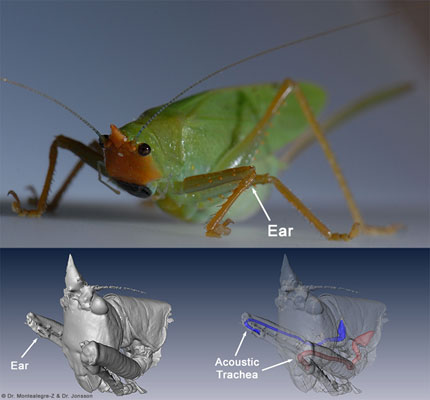Part of the research of HFSP Fellowship alumnus Dr. Fernando Montealegre-Z was to explore how Copiphora gorgonensis – a bush-cricket native to Colombia, South America – is able to hear and locate sound signals from potential mates. Vertebrates like mammals, birds and reptiles locate sound sources using differences in the times of arrival and amplitudes of sound signals that are due to the spacing of their ears on opposite sides of the head. The distance between the ears is creating time and amplitude differences that are big enough to be detectable by the nervous system and to calculate the origin of the signal. Different to vertebrates, bush-crickets have their small ears in their forelegs, which are only a few millimetres away from each other, making sound source location a challenging task. Each front leg exhibits a single ear below the knee with two tympanic membranes, which are backed by a narrow cylindrical tube (the acoustic trachea), which runs along the leg internally and opens out on the sides of the body (Fig. 1). Therefore, the eardrums in each leg receive sound from the external side, and internally via the tracheal tube, making this type of ear a ‘pressure difference receiver’.

Figure 1: The outer ear of Copiphora gorgonensis (Insecta: Orthoptera: Tettigoniidae). Top panel: habitus of the female. Lower panel: 3D computer reconstruction of the body using micro computed tomography. The left picture shows the body in transparency to expose the acoustic tracheae with its openings at the ears and at the sides of the body.
The researchers found that a single sound actually arrives at each bush-cricket ear twice, at different times and with different amplitudes, using the external and internal paths. This dramatically improves their ability to locate the sound source as the time and amplitude differences can be used to calculate the direction of the incoming signals. This significant new discovery helps to explain how these nocturnal insects use their advanced hearing systems to successfully locate their mating partners in the dark jungle.
This research, led by Dr Fernando Montealegre-Z, now a Reader (associate professor) at the University of Lincoln’s School of Life Sciences, used advanced laser technologies to show that sound reaches the ear externally at the normal speed of sound in air (344 m/s) and then again internally, via the acoustic trachea inside the animal, at a lower speed (~250 m/s). Curiously, the sound travelling inside the tracheal tubes is not only slowed down, but also amplified because the tube has the effect of an acoustic horn which functions a bit like an ear trumpet. Taken together, this means this tympanal membrane is receiving the signal twice: the first time at normal sound speed and with no amplification, and the second time slower but louder.
So, placing the ears on the forelegs (maximising the distance between them) and possessing an intricate internal tubing system allows the insect to hear a sound four times (twice in each ear). As these insects are nocturnal and the males sing to attract distant females for mating, this system explains how females are so good at finding the best singing males in the dark. Proving how this ear and the associated pipe with its sound speed reducing properties work was the key finding of our study and this information helps us to really understand how such sensitive and efficient hearing systems work.
The research was conducted in part as the initial HFSP fellowship research project conducted at the University of Bristol, and focused on the sound transmission properties of the bush-cricket’s acoustic trachea. The research took a different orientation when, by accident, a cochlea-like organ was discovered during the experiments on C. gorgonensis (results published in Science to show that these insects exhibit outer, middle and inner ear analogues (Montealegre-Z et al 2012)). The pioneering work on the trachea sound transmission was then put on hold, and now Dr Montealegre-Z and his postdoctoral associate Dr Thorin Jonsson at the University of Lincoln have opened the chapter again to show the complexity of these ears. The HFSP project pioneered the combination of state-of-the-art tools like micro-scanning Laser Doppler Vibrometry, micro computed tomography, and 3D computer and printed models of the insects’ ears and tracheal system. This initial research work within the HFSP fellowship permitted the analysis of this system at the fine scale, and was crucial to obtain a Leverhulme Trust standard grant, which permitted the completion of the research.
References
Auditory mechanics in a bush-cricket: direct evidence of dual sound inputs in the pressure difference receiver. Jonsson T, Montealegre-Z F, Soulsbury C, Robson Brown KA, & Robert D. (2016): Journal of the Royal Society Interface. 13, 1-11. DOI: dx.doi.org/10.1098/rsif.2016.0560.
Other references
Convergent evolution between insect and mammalian audition. Montealegre-Z F., Jonsson T., Robson Brown K. A., Postles M. & Robert D. (2012): Science. 338, 968-971. DOI: 10.1126/science.1225271.


































